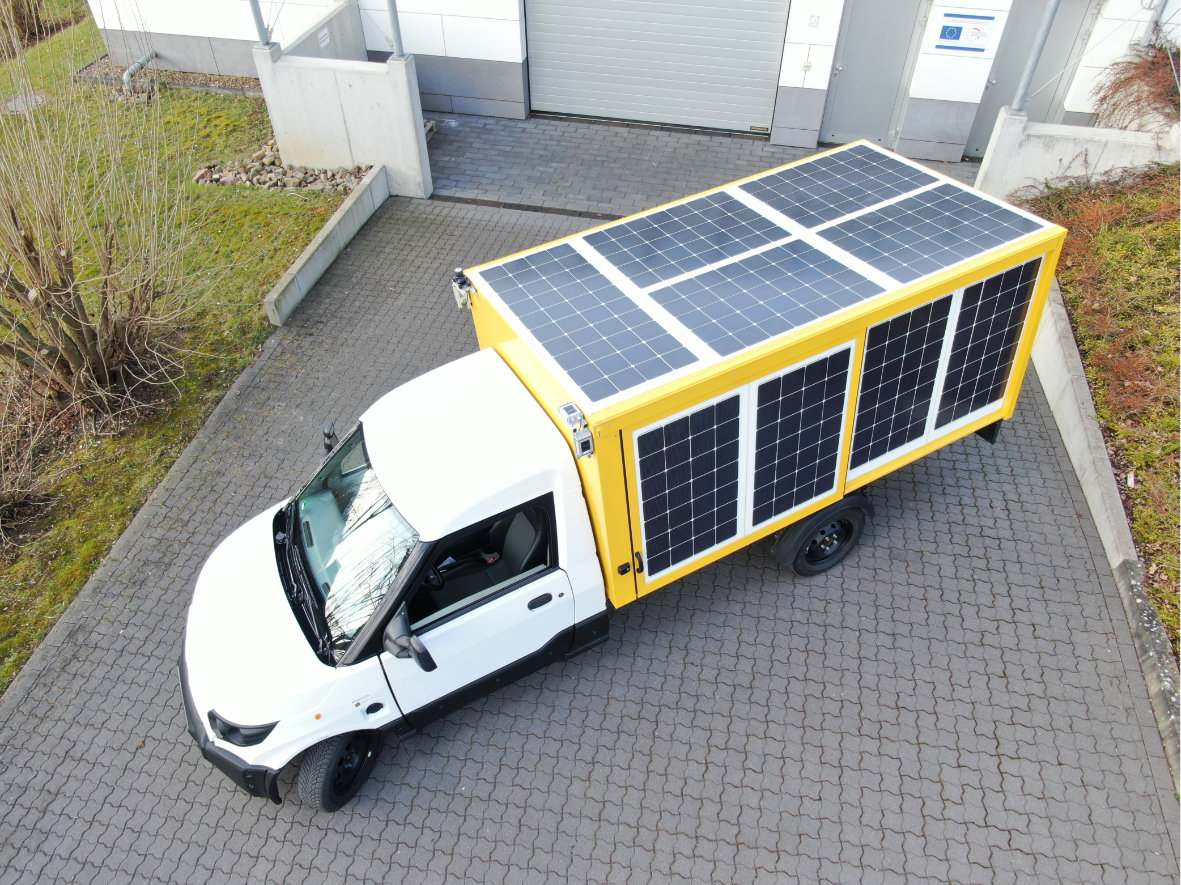The Institute for Solar Energy Research in Hamelin (ISFH) is developing a light commercial vehicle prototype equipped with vehicle-integrated photovoltaics (VIPV). The VIPV system will be connected to the vehicle's high-voltage electrical system and will be designed to extend its driving range.
The researchers have built the prototype based on the “Work L” small truck, which is manufactured by Germany-based manufacturer StreetScooter GmbH. The vehicles feature a total area of 15 m2 on which 10 PV modules can be deployed.
“The modules have been fabricated by a2-solar, a company with many years of experience in VIPV,” said Robby Peibst, ISFH professor and research coordinator. “So far, the modules are glass-based, reflecting a2-solar's experience in the passenger car sector.”
Peibst told pv magazine that the glass cover has the required surface quality for PV applications. It is also able to withstand stress from hail and extreme temperature changes. However, the weight of the glass-based modules might reduce the permissible payloads for delivery vehicles and trucks, he acknowledged.
“It is therefore a2-solar's development goal within the ‘street' project to integrate a second, foil-based and thus significantly lighter module generation on the commercial vehicle,” Peibst explained, adding that the current glass-based module generation scheme serves as a reference point, with an upgrade to be made by June.
The modules feature silicon heterojunction solar cells provided by Swiss manufacturer Meyer Burger.
“The cells were interconnected with the Smart-Wire Technology at ISFH,” Peibst said. “We think that this technology has a couple of advantages for VIPV, as, besides high efficiency, SHJ cells exhibit a low-temperature coefficient of only -0.2%/K and can be thin and thus partially flexible.”
The Smart Wire interconnection scheme should ensure that all parts of the cell are still electrically connected, even in the case of cracks and mechanical vibration. The 10 modules on the vehicle have a total capacity of 2.18 kW, with around 875 W being deployed on the rooftop alone. According to Peibst, the need to adapt the modules to fit the dimensions of the vehicle is a constraint on efficiency.
“You can see a lot of white areas which are only covered by the back sheet and not with silicon cells,” he said. “When going to half or even shingled cells, we will have more flexibility to fill the areas with silicon, which will strongly improve the module efficiency.”
The consortium behind the project includes the Jülich Institute for Energy and Climate Research, the Helmholtz Center Berlin (HZB), and the MBE Institute of Leibniz University Hannover, as well as German automotive supplier Vitesco Technologies. Their prototype vehicle has energy requirements that are similar to those of passenger cars, at around 19 kWh/100 km.
The research group looked at the irradiation on vehicles based on car-mounted pyranometers to determine the side-to- roof ratio, as well as the impact of dynamic shading. “When assuming a total driving distance of 20,000 km per year, the solar coverage fraction would be over 25%,” Piebst said. “We are currently trying to verify this prediction by extensive test drives.”
The consortium expects a higher annual range extension in more southern regions.
“Our results will demonstrate the attractiveness of vehicle-integrated photovoltaics first for such light commercial vehicles,” Peibst said. “But beyond that, they will also provide important insights for transferring VIPV to other vehicle classes.”
Peibst said that it is difficult to make a purely economic argument for VIPV, given that the depreciation periods for vehicles will be much shorter than those of stationary PV systems. “If you then pay a very low price for grid electricity, for example, as the operator of a large fleet of vehicles, it is really hard to argue with energy savings alone,” he acknowledged.
These difficulties do not preclude VIPV from becoming a bigger market possibility over the medium term, as Peibst pointed to a number of potential factors that could help to facilitate future growth. He noted that manufacturers of refrigerated trucks could reduce their CO2 emissions footprints if they integrate PV, for example.
In general, visible “green labeling” could gain importance among fleet operators, especially municipal operators of bus fleets and waste disposal vehicles. For environmentally minded drivers, VIPV could also simply be an expression of personal values, Peibst added, arguing that automated yet flexible mass production of VIPV modules could drive significant cost reductions, which in turn could open up additional potential applications.
“My very optimistic forecast for the global annual VIPV market in 2030 would be 5 GW,” Peibst concluded.
This content is protected by copyright and may not be reused. If you want to cooperate with us and would like to reuse some of our content, please contact: editors@pv-magazine.com.




Great Initiative for making VIPV Powered Vehicles.
It is not clear if the Vehicle has a Battery or just Use It-or-Lose It Solar System…..
Storage and Regenerative Braking Systems can help increase the Range substantially… specially for short hall urban use as actual running time is much lower in Stop-n-Go Applications. Adding a few more Panels (the image shows 9 Panels… 5 on Roof and Four on one Side but says 10..??) including above the Drivers Cabin and use of lightweight Polycarbonate etc…. in place of Glass and Body Panels/Roof could further reduce weight….. in any case a GREAT START…. !!!!